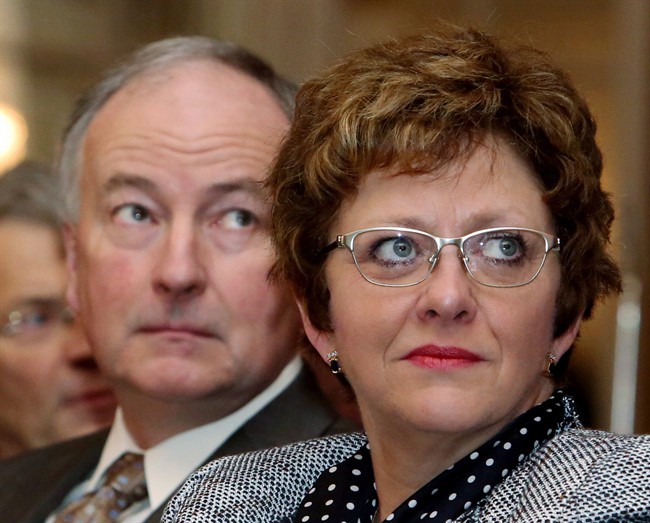OTTAWA – The equipment needs of the Canadian military will be assessed with a more skeptical eye under the Harper government’s new system of defence procurement.

The strategy, released Wednesday, also puts greater emphasis on arms exports by developing policies to “support international sales opportunities.”
The plan introduced by Public Works Minister Diane Finley and Defence Minister Rob Nicholson is meant to fix years of botched military purchases.
“Folks, I am pledging to you today that we are going to be managing things different and better,” Finley told an audience of mostly defence contractors and lobbyists at an Economic Club of Canada breakfast.
A series of delays and failed plans to re-equip the military have been a recurring embarrassment for the Conservatives.
READ MORE: Controversial F-35 purchase could bank Canadian businesses $9.9B
The auditor general’s bruising 2012 assessment of the plan to buy 65 F-35 stealth fighters left the government’s reputation for good fiscal management in tatters, with allegations that Defence and Public Works low-balled the price tag.
“We know there have been issues in the area of defence procurement and we’re not going to just wish these problems away,” Finley said. “Canadians have every reason to expect more from their government.”
The inability to deliver long-promised supply ships for the navy, and maritime helicopters for the air force, have also caused political problems for the government.
A $2-billion plan to buy armoured fighting vehicles for the army was scrapped just before Christmas. The system has even failed to deliver something as straightforward as 1,500 trucks.
- Posters promoting ‘Steal From Loblaws Day’ are circulating. How did we get here?
- As Canada’s tax deadline nears, what happens if you don’t file your return?
- Solar eclipse eye damage: More than 160 cases reported in Ontario, Quebec
- Video shows Ontario police sharing Trudeau’s location with protester, investigation launched
Finley said the government believes requirements set by the military “were too complex, and too often they appear to be set to achieve pre-determined outcomes.”
She was referring to the nearly decade-long effort to replace the country’s fixed-wing search-and-rescue planes in a process where the air force was accused of wiring the specifications to favour one bidder.
WATCH: Liberal leader Justin Trudeau said he believes the federal government has “completely botched” military procurement, and is skeptical of any strategy of theirs to address the issue after “eight years of ineptitude”
The new strategy introduces an independent challenge function within National Defence that will question the need for each major capability.
Affordability, especially in the face of declining defence spending, has been a key problem in many of the botched programs. The Conservatives have been repeatedly surprised by the price tags of some projects when it comes time to open the bids.
Another cornerstone of the plan will be consultation with defence industry contractors before projects go out the door. National Defence will begin posting an annual list of its equipment needs, beginning in June.
Tim Page of the Canadian Association of Defence and Security Industries said the posting will be a critical improvement for companies who often struggle to anticipate the priorities of National Defence.
The new system will also see increased co-operation among Defence, Public Works and Industry officials under an umbrella secretariat at Public Works.
The plan rejects creating an independent military procurement board, as other countries have done, and instead builds on existing structures and practices.
The government will also become more involved in steering Canadian defence contractors toward individual procurements.
Last year, former public works minister Rona Ambrose commissioned an outside report that recommended the government leverage planned defence spending as much as it can.
Finley and Nicholson were asked whether the replacement for CF-18 fighters will fall under the new system. Officials said if the government intends to scrap the F-35 program and go to an open competition, that program will be handled by the procurement secretariat.
Liberal defence critic Joyce Murray was skeptical about the effectiveness of the new strategy.
“I think it’s good the government has admitted their failure,” she said. “Procurement has been an utter failure for eight years.”
As much as $200 billion is expected to be spent over the next 20 years for trucks, helicopters, ships and fighter jets. Wednesday’s report said Ottawa has the opportunity to demand benefits for key industries and to encourage scientific innovation.
Beefing up defence exports is important for the overall economy, said Trade Minister Ed Fast.
“Canada will be more aggressive and effective than the intense competition we face in the defence sector … and this will ensure all of our diplomatic assets are harnessed to support and advance our commercial interests in key global markets,” Fast said in a release.
Follow @Murray_Brewster on Twitter



Comments